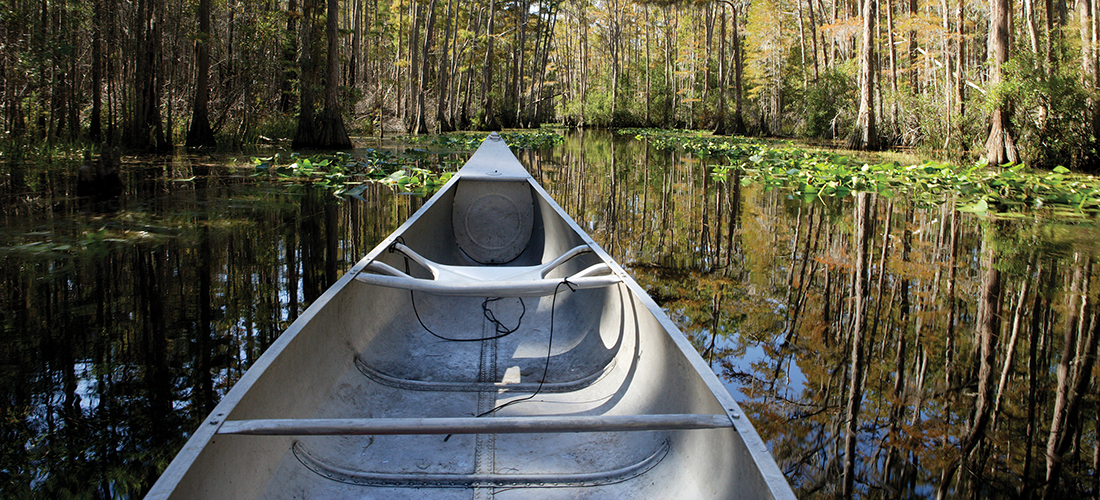
Lure of the Wilderness
Return to the Okefenokee
By Tom Bryant
I’ve been fortunate in my canoeing life on the water to travel to some fascinating places. At the top of the list is the Okefenokee Swamp, which borders the state lines of Georgia and Florida.
For the last several years, since retiring from my day job, Linda, my bride, and I have camped in Florida during the worst of the winter months. We like the western part of the state, mainly because it’s not quite as busy with tourists. But nothing stays the same. It seems the snowbirds from up north, escaping frosty winter weather, have found our last fishing location; and on this trip we decided to try another spot, Cedar Key, just a little north of Tampa. Folks I have talked with, and fellow campers, told me that that area has remained mostly unchanged in the past several years.
Also on this trip I determined to reacquaint myself with the wilderness stretch along the border of Georgia known as the Okefenokee. In the early ’80s, I made several excursions to the swamp, the longest being a seven-day circuitous paddle from the north landing down to the south and back again to where we started.
There are three put-in locations in the Okefenokee with the eastern entrance at Folkston being the most popular. I’ve put in at all three and like the southern entrance best, although it makes little difference. Once you’re in the swamp, everything begins to look the same.
Linda and I don’t plan to paddle the swamp on this trip. I just want to get the lay of the land for a winter adventure next year. Okefenokee, named by the Seminoles, means in their native language, “Land of Trembling Earth.” The swamp covers approximately 700 square miles. So, if you should decide to explore the area in a canoe or kayak, be prepared to live in the boat. There are 120 miles of canoe trails and very little dry land, so you’re confined to the canoe all day.
Overnight stops are placed at intervals to accommodate an easy day’s paddle — that is, if you don’t get lost. And that’s one thing you don’t want to do. The trails are marked and easy to follow as long as you stay on them. Venture off the trails and there could be trouble. The swamp looks mostly the same in every direction.
Officials at the put-ins require a party to sign in at every overnight stop; and with a controlled number of overnight wilderness permits issued, they can keep up with paddlers as they travel the trails.
The area has been protected since 1937 by the Okefenokee National Wildlife Refuge, and in 1974, a portion was designated a National Wilderness Area.
The headwaters of two rivers, the Suwannee and the St. Mary’s, flow out of the swamp. The Suwannee slowly drifts south through Florida, and the St. Mary’s flows east, delineating the border of Georgia and Florida. I’ve always wanted to paddle the crystal clear waters of the Suwannee, as it is supposedly the natural habitat of manatees. I’ll put it on the list, and maybe next year we can give it a go.
Fall and early spring are the busiest times to visit the swamp, with winter and summer being the slowest. To me, winter is the best time to take the trip. Migratory birds have arrived, and all species of waterfowl can be observed.
Remember, even though Okefenokee is considered semi-tropical, it does get cold in winter. On one trip I made in February, the low temperature set records, getting down to 18 degrees one night.
Any adventure to the swamp might put you in harm’s way as far as bugs, flying and biting, are concerned, so be prepared. Deer flies down there have been known to bite through clothing. Also, it helps to be in shape to live in the boat.
Water depth in the swamp is usually shallow, running from 2 feet to perhaps 9 feet in the canals. Once you’re deep into the watery prairies and away from the put-in areas, you seem to be transported to the days when the Seminoles were the only visitors.
The camping sites are raised platforms built about 2 feet off the water. They’re a welcome sight after a day’s paddle. The platforms have a roof over about three-fourths of the area that helps during the occasional rain shower but doesn’t alleviate the problem of flying, biting insects. I always carry a self-supporting tent with mosquito netting. This not only deters the bugs but keeps the ever present, night prowling raccoons at bay. Another point: Store all food in a cache; hungry animals are about. Oh, and most important, a porta-john is located on a corner of the platform. All the conveniences of home, just about.
Stay on the platforms after dark. Nighttime is not the time to be on the water. That’s when alligators look for food. And there are some big alligators in the swamp. Ten to 12 feet. You can understand the request from the rangers: When the sun goes down, stay in town.
I haven’t been back to the swamp in years, but on this trip south, Linda and I are gonna check out the happenings in that area and put it high on our agenda for next year; that is, if it’s still as I remember it.
If you’re gonna go, I would advise making reservations early. Call the Okefenokee Wildlife Refuge at Folkston, Ga. Good luck, and I hope to see you in the swamp. PS
Tom Bryant, a Southern Pines resident, is a lifelong outdoorsman and PineStraw’s Sporting Life columnist.





